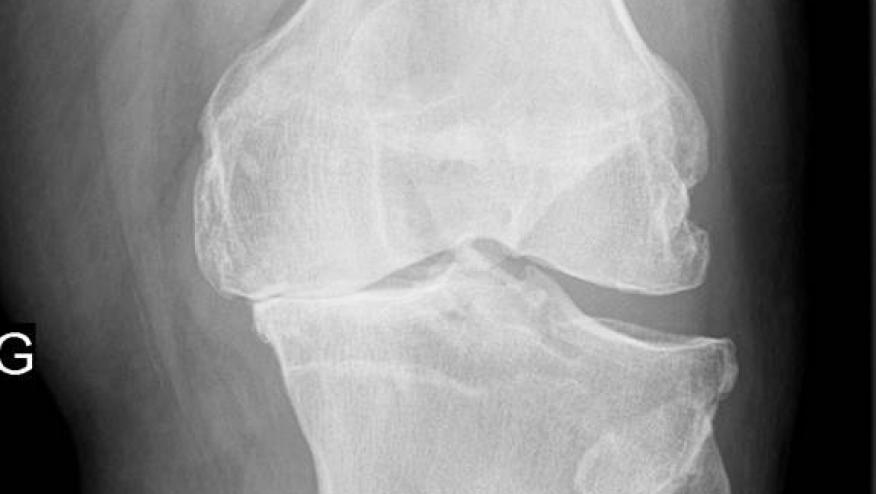NSAIDs in Osteoarthritis: Study Suggests Need for New Look Save

Knee osteoarthritis (OA) patients using nonsteroidal anti-inflammatory drugs (NSAIDs) showed greater loss of medial minimum joint space width than did others taking other drugs, registry data indicated.
Compared with current non-users of NSAIDs, those who were treated with these medications had a loss of minimum joint space width (β = -0.042, 95% CI -0.08 to -0.0004, P=0.048), reported Thomas A. Perry, PhD, of the University of Oxford in England, and colleagues.
But during 8 years of follow-up, no relationship was seen between joint space width and the use of statins, antihypertensives, antidepressants, osteoporosis medications, or diabetes medications, according to the team's study online in Rheumatology.
Current treatments for OA include both nonpharmacologic and pharmacologic modalities, and particularly analgesics to control symptoms. Widely used analgesics include NSAIDs, cyclooxygenase (COX)-2 inhibitors, and intra-articular medications.
The effects of analgesic use on structural progression in OA are unclear. Some studies have suggested that NSAIDs may block the synthesis of cartilage matrix, which could encourage the development of OA, while others have suggested that COX-2 inhibitors may be protective through inhibition of prostaglandins. Additional studies have linked the use of intra-articular steroids with structural progression, whereas others found no effects of steroid injections.
Further uncertainty exists regarding the potential effects of other types of medications used for morbidities that are common among patients with OA. For instance, recent research has suggested that diabetes medications may be protective: Metformin might have anti-inflammatory effects through inhibiting Th17 cells and upregulating Treg cells. Antihypertensive medications could reduce the likelihood of progression by alleviating the cartilage-degenerating effects of hypertension.
Therefore, to explore the potential effects of medication use on structural progression in knee OA, Perry's group analyzed data from 2,003 individuals enrolled in the Osteoarthritis Initiative.
All had evidence at baseline of radiographic OA, with Kellgren-Lawrence grades of 2 or higher in one or both knees. Knee radiographs were obtained yearly for 8 years. Covariates included in the analysis included age, sex, race, body mass index (BMI), pain, and severity of OA.
Participants' mean age was 63, more than half were women, three-quarters were white, and mean BMI was 29.8.
At baseline, prescription NSAIDs were being used by 14.7% of patients, COX-2 inhibitors by 9.7%, steroids by 9.5%, opioid analgesics by 5.1%, and acetaminophen by 3.8%.
Other commonly used medications included statins in 27.4%, antidepressants/anxiolytics in 14%, osteoporosis medications in 10.9%, angiotensin-converting enzyme (ACE) inhibitors in 15% of patients, beta-blockers in 14.9%, and diabetes medications in 6.9%.
On a univariate analysis, significant associations were seen with medial minimum joint space width for NSAIDs, opioid analgesics, statins, and antidepressants, but on the multivariate analysis only NSAIDs remained statistically significant, with the medial joint space width being -0.042 mm smaller among current NSAID users compared with non-users.
For other analgesics, no significant associations were observed:
- Acetaminophen, β = -0.043, 95% CI -0.12 to 0.03, P=0.25
- COX-2 inhibitors, β = -0.046, 95% CI -0.13 to 0.035, P=0.27
- Corticosteroids, β = -0.006, 95% CI -0.06 to 0.04, P=0.81
Other types of medications also showed no associations:
- Osteoporosis medications, β = 0.01, 95% CI -0.05 to 0.07, P=0.75
- Statins, β = -0.034, 95% CI -0.08 to 0.01, P=0.11
- Antihistamines, β = 0.03, 95% CI -0.03 to 0.09, P=0.30
- Antidepressants, β = -0.048, 95% CI -0.10 to 0.01, P=0.095
- Diabetes medications, β = -0.02, 95% CI -0.05 to 0.1, P=0.56
No associations were observed for cardiovascular medications as well:
- Beta blockers, β = -0.02, 95% CI -0.07 to -0.03, P=0.38
- ACE inhibitors, β = -0.015, 95% CI -0.06 to 0.03, P=0.53
- Angiotensin receptor blockers, β = 0.026, 95% CI -0.03 to 0.08, P=0.35
- Calcium channel blockers, β = -0.04, 95% CI -0.09 to 0.01, P=0.11
Despite the finding that current NSAID use was significantly associated with loss of medial joint space width, the investigators cautioned that it was "unlikely that these changes are clinically relevant as they fall short of conventional thresholds" that would qualify a patient for total joint replacement.
"Clinical trials are needed to [further] examine the disease-modifying effects of medications in radiographic knee OA," Perry and co-authors concluded.
A limitation of the study, they said, was its observational design.
The authors reported financial relationships with Pfizer, Eli Lilly, TLC bio, Merck Serono, Novartis, Merck Sharp & Dohme, Roche, Smith and Nephew, Q-MED, Nicox, Servier, GlaxoSmithKline, Schering Plough, Rottapharm, Alliance for Better Bone Health, and Amgen.








If you are a health practitioner, you may Login/Register to comment.
Due to the nature of these comment forums, only health practitioners are allowed to comment at this time.